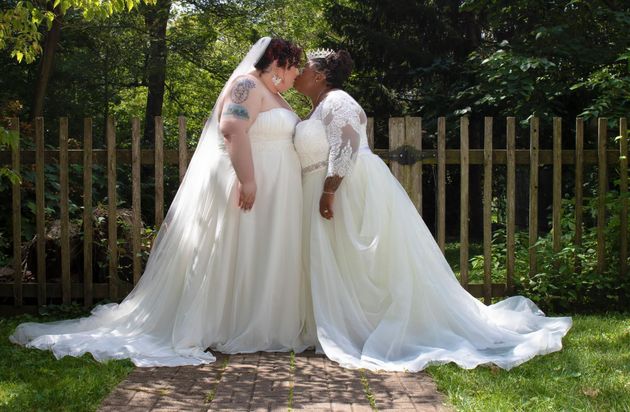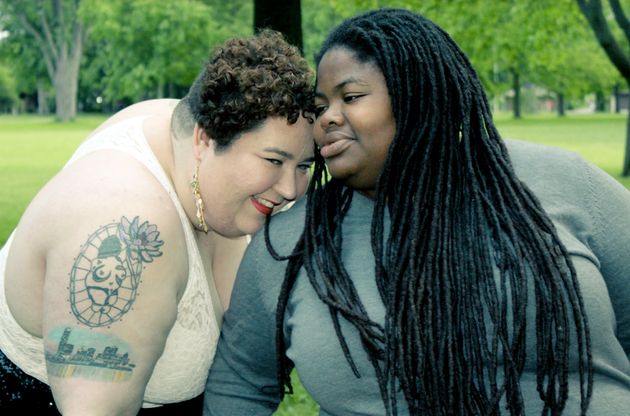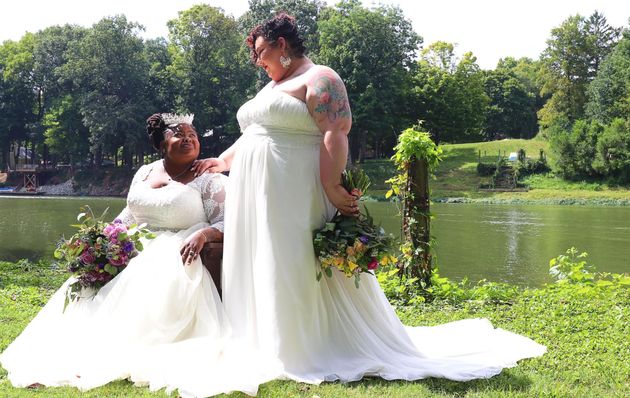
I wasn’t surprised when she proposed. Morgan and I had been together for three and a half years. We moved across the country from Brooklyn to Milwaukee and had picked out our engagement rings the month before.
In August 2019, Morgan took me to Lake Michigan. We stopped on the long wooden staircase leading to a semi-private beach, under a thick canopy of tree branches by the water. Morgan held out the ring and asked me, softly, if I would “do that thing, and you know, marry her.”
“Of course,” I said, tears running down my cheeks. It felt right.
Our little family was the furthest thing from the traditional Chassidic family I grew up in, with long sleeves and high necklines, insulated from the world without TV and non-Jewish music or books, so my parents wouldn’t attend. Morgan’s Jamaican parents never supported our relationship, or her gayness. When she called to inform them of our big news, they said, “So you found yourself a man?” Morgan hung up. They followed up with text messages, saying that they “didn’t believe in all that.” Since wedded bliss for “people like us” could only be done “with a man,” they certainly wouldn’t consider attending ― it wasn’t even something available for discussion. She told me she never dreamed of a wedding and wanted to marry in Vegas.
As the oldest of 15 children born to a Chasidic rabbi, I had already worked through several wedding dreams. I knew exactly what kind of a wedding I was to have by the time I was just out of diapers, as I had already seen my parents’ wedding video replay countless times. As I grew older, I attended weddings of my young teachers and family friends.
The weddings were all pretty much the same. I knew I wouldn’t see my groom in the week before my wedding. Within four days before the ceremony I would purify myself of the “filth” that my menstrual cycle brought by ritually immersing myself in a bath of rainwater. The ceremony itself would take place in darkness ― but only for me. I would have my face covered by an opaque veil, albeit be briefly exposed to confirm that I was the appointed woman, not a substitute. “Tradition.”
Because I grew up experiencing physical and emotional abuse, I was eager to marry a stranger just to escape from the reality of my existence. So, when I was 15, I sat opposite my father in his cramped office, a converted bedroom in a single story home-turned-synagogue and told him I was ready to be married. While Chassidic Jews had historically married young, the Chabad sect we were a part of had drifted away from that tradition. I, however, made a good argument: I was fully grown, I could cook and clean, and, therefore, I would make a good housewife.
I knew by that point that my sexual attraction extended beyond the male gender, but I also understood my desires were unlike those of the other young women I knew. At the time I thought my feelings for women were nothing more than a sex thing ― a kink ― and without anyone to talk about them with or a way to explore them, I ignored them and concentrated on finding a husband.

As my father began to navigate the waters of arranged dating for me, as was traditional in my community, he put out my name and readiness to marry to the people who would connect him with eligible suitors. You see, in arranged dating, my parents would vet the candidates for my hand before I would meet them, only allowing me to consider ones they found suitable. It was then that he found the flaw I hadn’t seen. I was too fat, which made my dating resume a tougher swallow for potential suitors, especially since the facts were outlined without as much as a photograph. He started demanding that I lose weight, going as far as requesting a weekly weigh-in at the local UPS store, the only place I knew of with a scale.
But before my father could find someone who found me worthy of consideration, the lifetime of abuse I was enduring ― including three fractures in my back ― finally caught the attention of Milwaukee Child Welfare authorities. I was abruptly taken from my community, placed into foster care, and dumped into a world I knew nothing about. It should have happened years earlier, but it took time for the countless police reports and CPS complaints before someone believed what I had to say about what was happening behind closed doors.
As I learned to live in a strange new secular world, I devoured romance novels by Nora Roberts and Nicholas Sparks, among countless others, that the public library sold ― the ones where the paperback was too worn to keep in circulation. Even though these books presented visions of intimacy and adoration that I had never encountered, I used them as my escape and allowed myself to dream of a reality that was loving and peaceful, where romance was abundant and broken people were healed by love.
It was in my first group foster home, a few months before my 17th birthday in 2011, that I saw Kim Kardashian’s televised wedding. I watched Kim walking down the aisle in her sleeveless wedding gown ― her bodice fitted like a glove around her tiny waist and her veil trailing behind her as everyone in attendance drew a breath.
No one on that screen looked like me ― no one had the life story I did ― but it didn’t feel like that mattered. I began to dream of the romance of it all ― big white dresses, large diamonds, bridesmaids, and limousines ― and I wanted it for myself.
It was in that same group home, just a short while later, that a girl first told me she had a crush on me. An icy feeling of confusion swept through me, and, unsure what to do about it, I told Jessica, a woman that worked there. “Sexual relationships are strictly forbidden,” she sternly informed me, leaving me to try and grasp and understand the magnitude of these feelings. After a few months ― and much research and self-reflection ― I came out to my first foster dad, a Chassidic Jewish man. Days later, I’d moved on to my next foster home, and then on to the next.

By the time Morgan proposed to me, my dream of a glamorous wedding and all that it would entail ― and cost ― had shrunk. It just wasn’t practical. According to the Knot, the average American couple spent $33,900 on their wedding in 2019. I could pay off my student loans in their entirety with that money! I joined bridal Facebook groups and I read comments from folks stressing out about their 175-person guest lists, elaborate floral decorations and dress regrets. I just couldn’t see myself having all of that. I realised I just didn’t want it.
Before the end of 2019, my future wife and I decided to pick between one of two wedding scenarios. Either we would have a small celebration with 30 people in a park or a backyard, or we would fly back to New York City, where we had met, and we’d throw a big queer party on someone’s roof like a queer romance novel come to life. I envisioned a huge grazing table filled with soft and hard cheeses, nuts, cured meat, and jars of honey. We would roast a pig in a pit. Guests from around the globe would fly in to celebrate us, finally, surviving and thriving.
Then came the dark cloud of the coronavirus pandemic.
So, I ratcheted down my dreams further. I called the county clerk to find out how to get a marriage license. They weren’t issuing any at that time. The next county over was, but unless we lived there, they couldn’t issue us one. I lost my job at the collision shop where I worked, and decided to make my part-time automotive education business a full-time career.
Yet in the midst of all of this, our desire and need to be married increased. What would happen if we got sick?
In July, we decided it was time to move forward and chose to get married in Indianapolis, Indiana, just a few hours’ drive from our home in Milwaukee. It was easy to get a marriage license there ― much of the process to apply was online and there was no waiting period.
I thought I would feel pangs of loss ― that somehow my wedding dreams, even incredibly simplified, would not come true. Instead of wallowing, I threw myself into preparing for the wedding, a date that we set just one month out to prevent us from being stopped by the inevitable second wave of the pandemic.
I focused on all the little details, making sure that the ceremony reflected our belief systems and love for each other without ownership, that the vendors that would be involved were from communities we wanted to support. And while there could be no in-person guests, we sent out a digital invite to the “Biggest, Queerest Wedding of the Year,” and watched in awe as thousands of people RSVP-ed.

Black, queer and plus-size woman would be at the heart of our day. Jasmine Howard would do both of our hair styles. Danielle Lawson took photographs. Ja’Twon Henderson would make sure our makeup was as glamorous as our dresses. When we looked for an officiant, I wanted to make sure it was also someone who reflected our values and would be willing to work collaboratively to create the ceremony we wanted. L.S. Quinn, who had been doing queer commitment ceremonies before it was legal to do so, was exactly who we were looking for.
As we were getting ready, I watched my bride eat curry goat with her hair all done up and a crown sewn into her locs. She was wearing a red polo with little sailboats embroidered on it and blue jeans, looking exactly like the woman I fell in love with years before. I felt at peace. Then she donned the long-sleeve ball gown she’d chosen to marry in, along with the aforementioned crown, the diamond necklace and earrings I gifted her, and Birkenstocks. When I saw her again, she was completely transformed. Majestic. As we stood across from one another and committed ourselves to doing the work that would make our love work, over 10,000 people joined our Facebook livestream to celebrate. It was a perfect wedding.
When it was all over, we sank down next to each other on a couch, both of us enveloped in our wedding dresses, and watched the recording of the livestream. Reading the well wishes from people across continents and seeing what an impact it made on those who joined us brought me to tears all over again.
I realised I didn’t need a Kim K wedding to profess my love for my wife. Our wedding brought people from all over the globe together for a moment of joy and peace, a brief reprieve from the tumultuous world outside. It was exactly what we needed, and though different from the dreams I once dreamed, it was truly a dream come true.
Chaya Milchtein is an automotive educator, writer, and speaker, as well as the founder of Mechanic Shop Femme. This article first appeared on HuffPost Personal.
Have a compelling personal story you want to tell? Find out what we’re looking for here, and pitch us on ukpersonal@huffpost.com